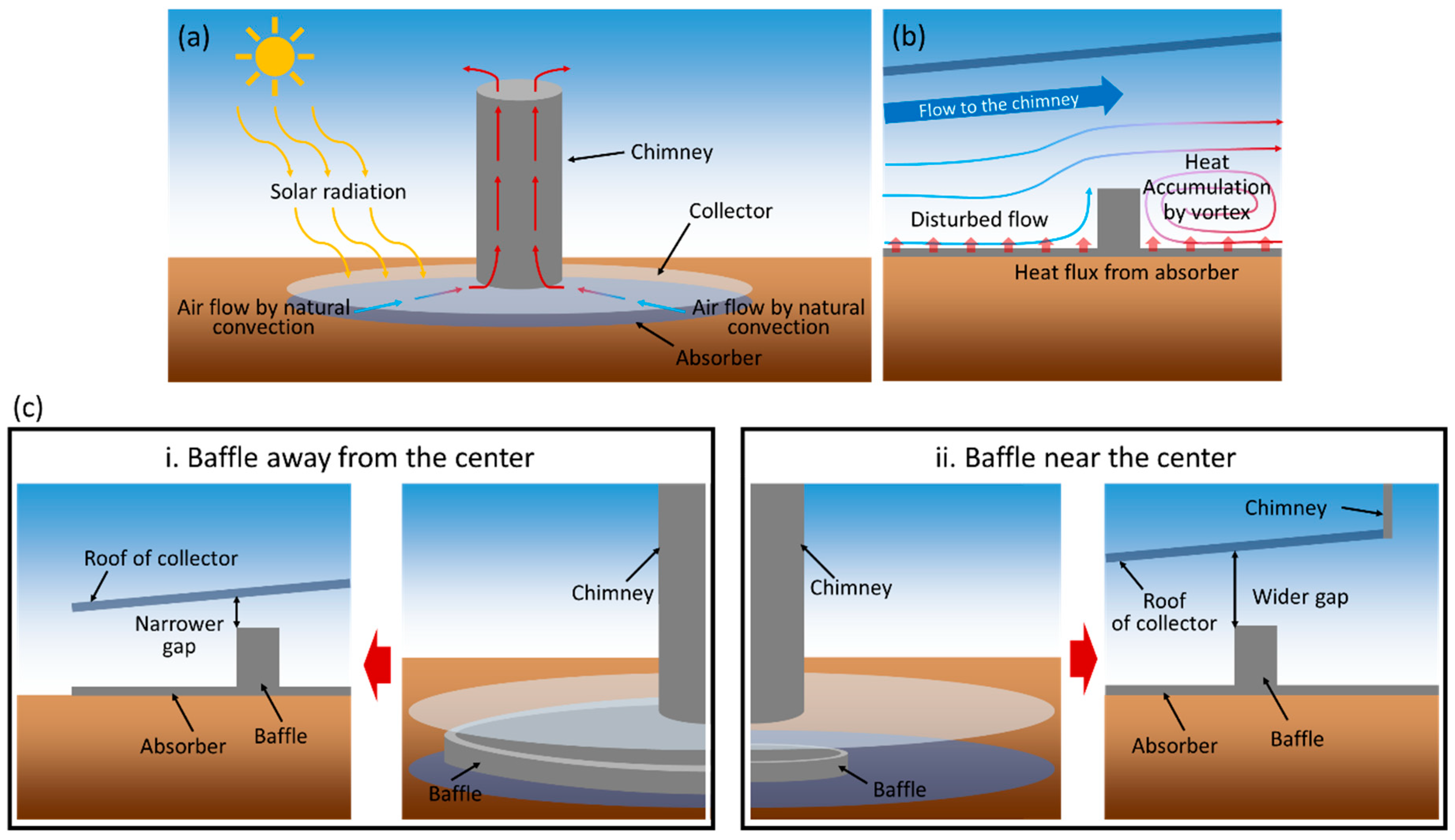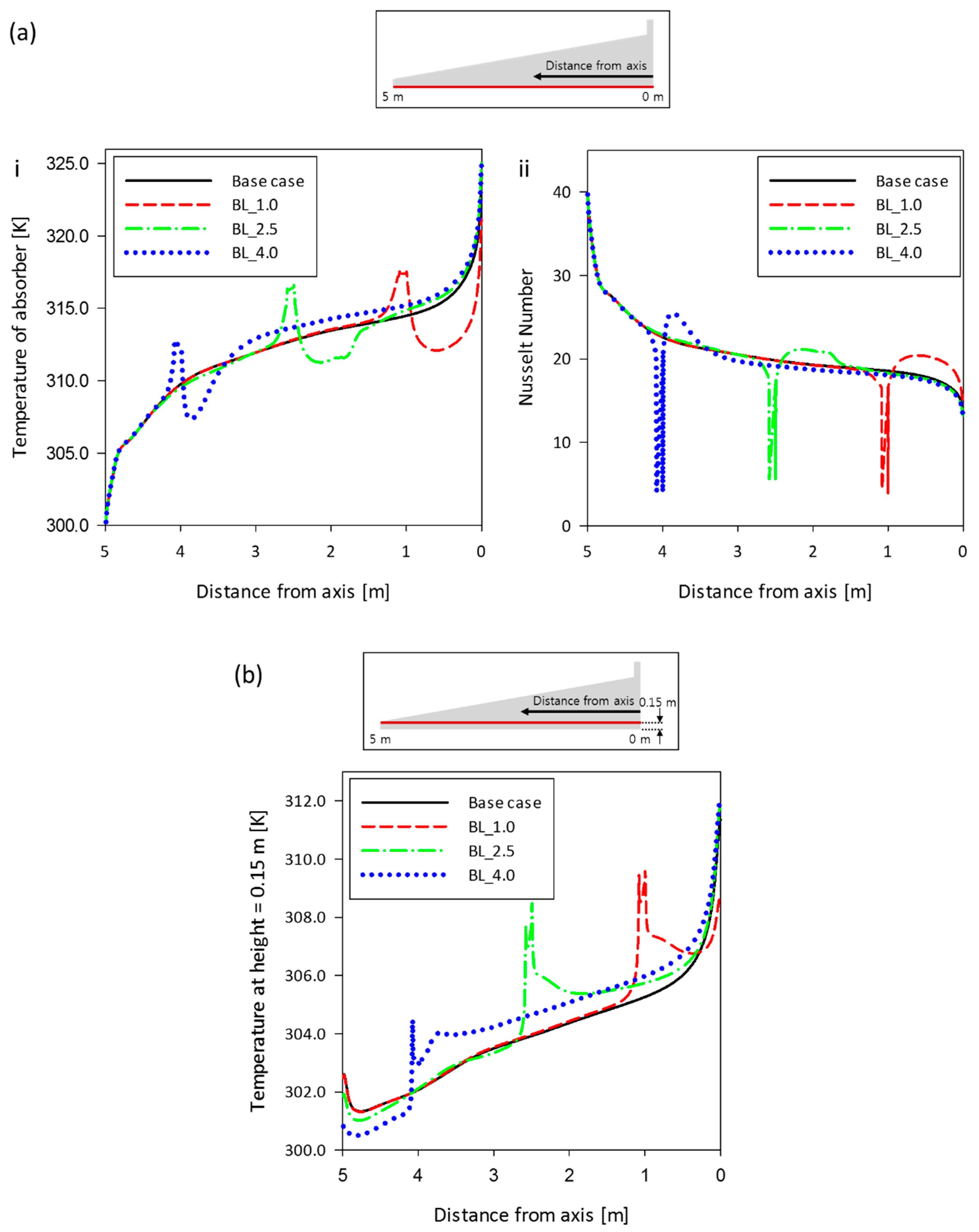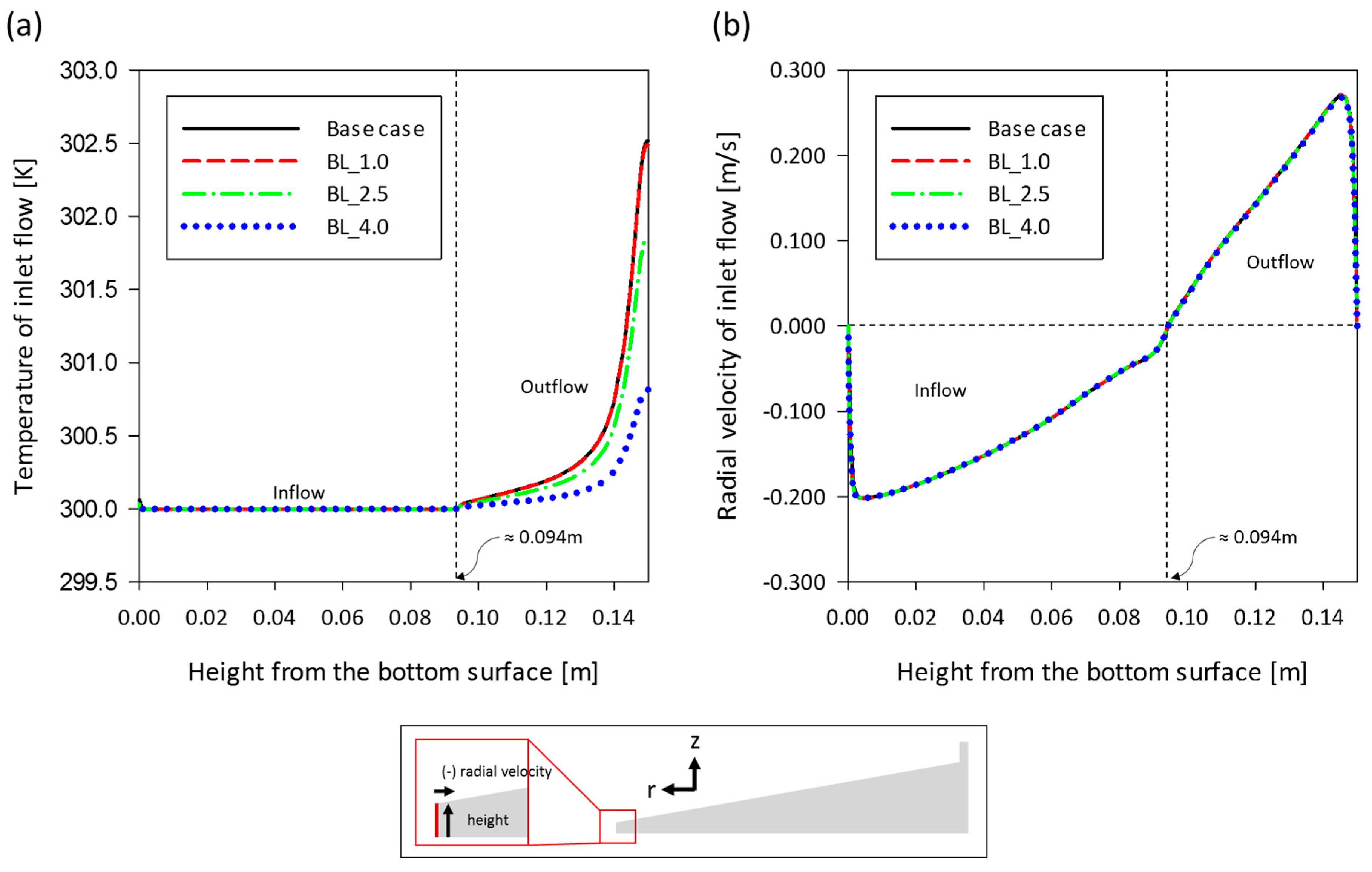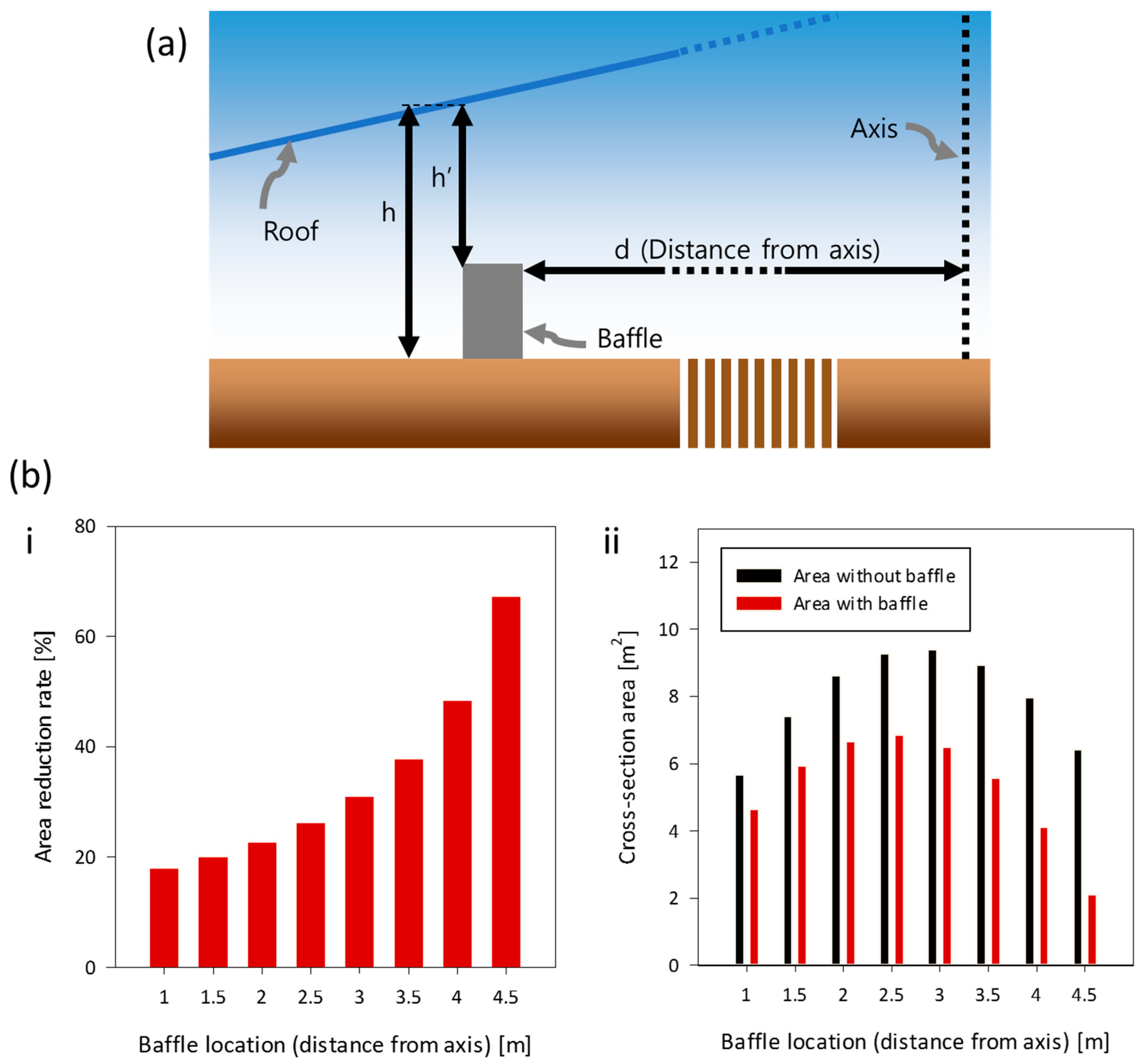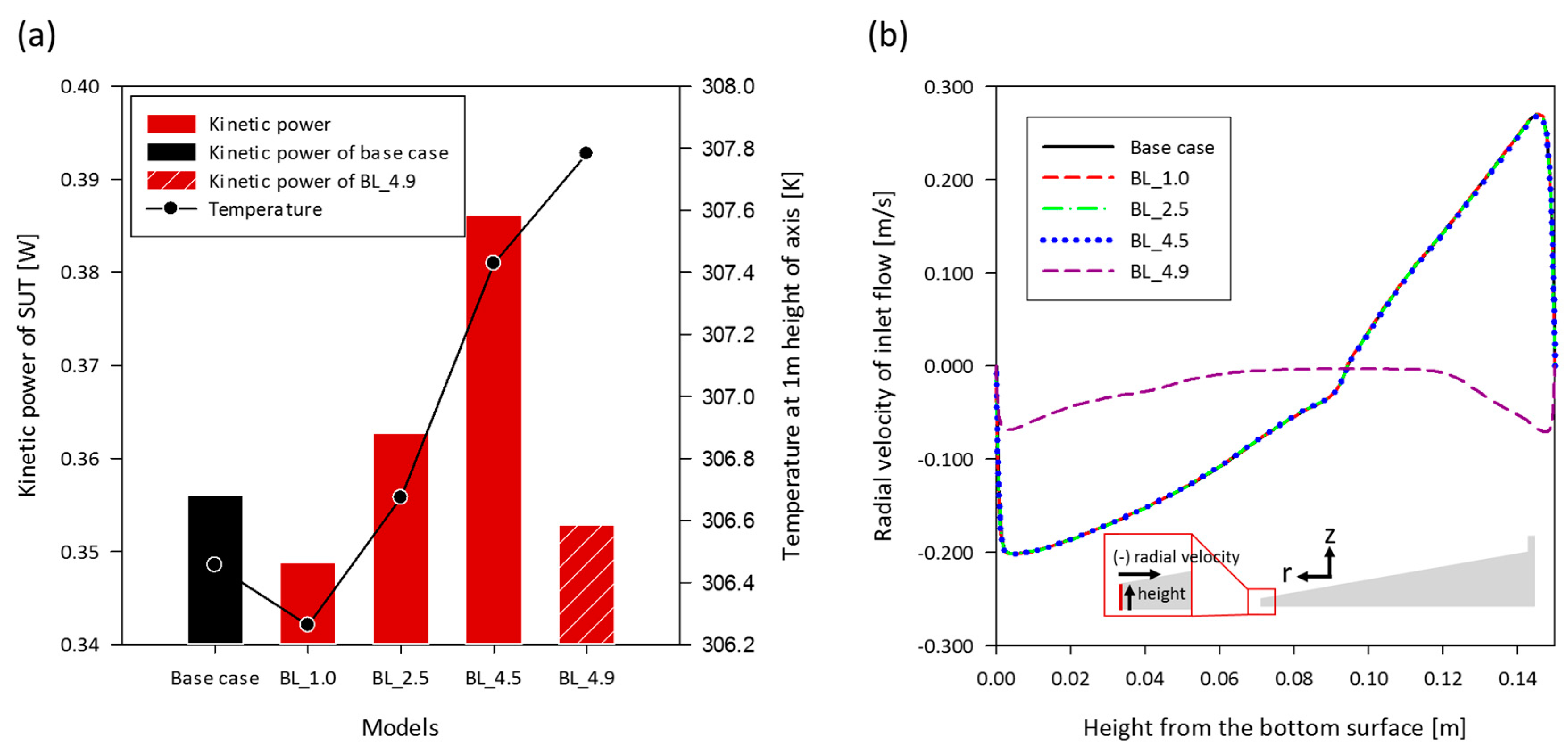1. Introduction
Interest in renewable energy is growing around the world as the Paris Agreement was signed in 2015 to reduce global greenhouse gas emissions, the cause of global warming [
1]. As this trend develops, various methods of power generation from natural resources with little greenhouse gas emission, such as biomass [
2,
3], wind power generation [
4], and geothermal power generation [
5], are being studied. Regarding solar energy, the annual amount of solar radiation reaching Earth’s surface is approximately 3,400,000 EJ (exajoule, 1 × 10
18 J), which is more than 7500 times the annual world primary energy consumption of 450 EJ [
6]. This is a very considerable source of energy and is expected to be utilized as an abundant renewable resource. Therefore, various solar energy applications such as solar water heaters, solar cookers, solar dryers, and solar ponds are being studied [
6]. Among them, the solar updraft tower (SUT) is a power generation system that uses thermal updraft air flow caused by the natural convection phenomenon of the ground’s air heated by solar radiation. In general, the SUT consists of a chimney located at the center, a collector that receives solar radiation, and an absorber that forms the bottom of the SUT (
Figure 1a). The collector passes the short wavelength solar radiation, delivering energy into the SUT. When this absorbed energy is reflected on the absorber, its wavelength becomes longer and does not pass through the collector. This is the basic principle of the greenhouse effect by which the SUT operates. The air inside the SUT receives thermal energy from the absorber, which eventually causes the density difference with the outside air, and the air is buoyant and rises through the chimney. The kinetic energy of the rising air flow is used to generate power by operating a wind turbine near the entrance of the chimney.
Since the initial concept of the SUT was first proposed in the late 1970s [
7], various studies have been conducted on the operating conditions (such as weather condition in Saudi Arabia [
8]) and geometries of the SUT (such as diverging chimney [
9,
10] and sloped collector [
11]). In addition, research studies have been conducted that address the topic of combining a SUT with another system or installing various types of devices. For example, an experimental investigation was performed where the floor of a SUT was covered with a phase change material that stored heat during the day and released it at night [
12]. Furthermore, papers on the effects of installing a baffle in the collector of a SUT have been reported [
13,
14]. A baffle is a flow-directing panel that is commonly installed in heat exchangers [
15] for maximizing the thermal efficiency of a system; alternative types of baffles include the segmental type [
16], the donut type [
17], and the helical type [
18]. It was reported that a baffle installed in a SUT generated a vortex and increased the Nusselt number (the ratio of convection heat transfer to conduction heat transfer on the surface of an object), enhancing the heat transfer and, thus, the power output of the SUT [
13]. More recently, opposing effects caused by the baffle shape (height) changes have been reported [
14]. The positive effect is due to the increased amount of heat transfer to the air in the collector by the vortex occurring behind the baffle, and the negative effect is due to the reduced cross-sectional area of the flow path blocked by the baffle. This implies that the baffle can cause various thermo-fluid dynamic phenomena and effects, and thus, a more diverse analysis is needed on the design parameters (such as shape, number, and position) of the baffle.
In the present study, a numerical analysis is carried out on the appropriate positions of baffles in the SUT. The thermo-fluid dynamic effects of the baffle are examined by varying the position of the baffle in the collector. The position of the baffle affects both the downstream recirculating flow area and the upstream cold air inflow from the outside. The enhancement of the greenhouse effect by the downstream recirculating flow is a positive effect on the thermal efficiency point of view (
Figure 1b). On the other hand, the baffle also reduces flow area and increases flow resistance. This is a negative effect of the baffle, which causes a decrease in the total flow rate (
Figure 1b). According to the position of the baffle, both the size of the gap through which the flow passes and the vortex generation location are also changed, so that the magnitudes of the abovementioned two effects and the flow characteristics are also to be changed (
Figure 1c). In order to quantify these conflicting effects, computational fluid dynamics (CFD) models for eight baffle positions were analyzed in order to propose an appropriate baffle position with the maximum net thermo-fluid dynamic effect. The results presented in this paper will be useful not only to verify the thermal usefulness of the baffle applied to the SUT but also to guide SUT designs for an improved performance in the future.
3. Results and Discussion
By scrutinizing the streamlines of the flow in the collector, it was found that two major flows were developed—the “main flow” directed to the chimney and the “circulating flow” (
Figure 3a). The most prominent difference between the control model (base case, without baffle) and the other models with a baffle is an additional vortex formed immediately behind the baffle in the main flow. The circulating flow in the base model is formed throughout the collector (see the blue region in
Figure 3a); this flow pattern, however, is changed by the small vortex generated behind the baffle. For convenience, we classified them into three groups according to the location of the baffle (
Figure 3). First, the circulating flow in Group 1 (BL_1.0, BL_1.5, and BL_2.0;
Figure 3(bi)), where the baffle is located relatively close to the chimney (axis), is formed between the inlet and the baffle contacting directly with the inlet flow from the outside. In Group 2 (BL_2.5 BL_3.0, and BL_3.5;
Figure 3(bii)) for which a baffle is located in the middle of the collector, the shape of the circulating flow becomes narrower and is divided in the middle by the baffle (and the corresponding vortex generated behind it), creating two circulating flows in the upstream and downstream regions of the baffle. The circulating flow formed at the upstream of the baffle of Group 2 is in direct contact with the external flow introduced into the collector inlet (the same as in the circulating flows observed in the models of Group 1); however, the circulating flow formed in the downstream of the baffle is isolated. In Group 3 (BL_4.0 and BL_4.5;
Figure 3(biii)) for which a baffle is adjacent to the inlet of the collector, the circulating flow is not in direct contact with the inlet flow since it is secured by the baffle, which protects the circulating flow from mixing with the inlet flows.
Such changes in the flow pattern also lead to temperature distribution changes in each model. To confirm this, we examined the temperature profiles at some specific locations. Note that we selected BL_1.0 for Group 1, BL_2.5 for Group 2, and BL_4.0 for Group 3 as the representative model cases of each group). First, the temperature profiles of the absorber surface (h = 0 m) of the represented models showed a rapid rise around the baffle and a relatively low temperature just behind the baffle (
Figure 4(ai)). This was due to the vortex formed in the main flow at the rear of the baffle. In the model without a baffle (the base case), it was observed that the temperature “gradually” increased as the temperature approached the chimney without any fluctuation. This was because the flow that acted as a heat transfer medium in the base case proceeded without any hindrance that caused abrupt changes (
Figure 3a). On the other hand, in the models with baffles, a vortex was formed behind the baffle, delaying the overall flow of the collector (
Figure 3b) and enhancing the heat transfer inside the vortex. This is explained more clearly by the Nusselt number (the ratio of convection heat transfer to conduction heat transfer on the surface of an object), which is relatively higher as the flow passes over the baffle (
Figure 4(aii)). It also implied that the vortex behind each baffle carried away the locally heated air, resulting in a higher convective heat transfer rate and a higher Nusselt number. Contrarily, the Nusselt number graph before each baffle was meaningfully low because the flow was stagnated by the baffle structure, minimizing the convective heat transfer. Also, as the baffle approached the center of the collector, the temperature rise at the baffle position tended to be even higher. The temperature profile of the tip height (h = 0.15 m) of the baffle was a position slightly away from the absorber where the heat flux was generated (where the heat exchange of the main flow and the circulation flow was more advanced). The temperature distribution in this area showed the influence of the flow, depending on the baffle position on the temperature distribution in the collector (
Figure 4b). In all cases, the temperature downstream of the baffle was generally higher than the temperature upstream. This tendency was more apparent when the baffle was located closer to the collector inlet. In other words, the temperatures upstream and downstream of the baffle had a larger gap. This shows that the baffle prevented the heat in the downstream space from flowing out upstream of the baffle and that the function of this baffle was more effective when the baffle was closer to the collector inlet. The extent to which the internal heat flows out could be seen through the temperature distribution at the inlet of the SUT is shown in
Figure 5a. The inlet injects air mainly from the outside, but due to the action of circulation flow, some air may leak out to the outside. The flow from the bottom (absorber) of the inlet to a height of approximately 0.094 m inflows to the collector, and the flow above a height of approximately 0.094 m is an outflow from collector to the outside. This can be seen from the radial velocity profile of the inlet with the
x-axis set to height (
Figure 5b). The high temperature of this outflow relative to ambient air (300 K) means that the outflow effuses the internal heat from the absorber. Therefore, the outlet temperature is, preferably, as low as possible to preserve the internal heat, and the closer the baffle is to the collector inlet, the lower this temperature is. The effect of this baffle affects the temperature distribution of the entire SUT as well as the temperature distribution of the specific location. First, the temperature contour of the representative models of each group (BL_1.0 of Group 1, BL_2.5 of Group 2, and BL_4.0 of Group 3) shows that the temperature is generally high at BL_4.0, where the baffle is located far from the center. In addition, the temperature of BL_2.5 and BL_1.0, where the distance gradually decreases (
Figure 6a), decreases in order. This tendency of the temperature to change is also observed near the central axis where the “main flow” rises through the chimney (
Figure 6b). This is an important position where the ascending “main flow” is located, and the high temperature at the center means that the heat flux generated from the absorber is well preserved in the SUT.
These changes in the flow and temperature distribution affect the rising air flow in the SUT and are directly related to the kinetic power of the fluid. When the turbine is located at the entrance of the chimney, the kinetic power of the fluid at the location is transferred to the turbine to produce power, so that the kinetic power of the fluid can be used to confirm the power generation performance [
22]. The kinetic power, P, was calculated using the following equation.
where
is the density, which is a constant due to the Boussinesq approximation;
Ac,in is the cross section of the chimney; and
V is the volume flow through the chimney inlet. Both the kinetic power calculated from this equation and the central axis temperature at a height of 1 m of the chimney inlet have the same tendency to increase as the baffle moves away from the center (
Figure 7). Since the central axis at a height of 1 m is the position where the rising air current is generated, the relationship between the temperature and the kinetic power at this point can confirm whether the heat transfer of the SUT affects the performance of the SUT. Since the two values show the same tendency, the temperature distribution of the SUT is an important factor in the performance. The change of the temperature distribution according to the position of the baffle is also an important factor in the performance determination. In the case of BL_1.0 and BL_1.5 (located close to the center), the temperature distribution and kinetic power were lower than those of the baffle-free base case (BL_1.0 had a lower kinetic power by –2.04% and BL_1.5 had a lower kinetic power by –1.5%), and BL_2.0 is also very slightly higher than the base case (a slightly higher kinetic power by 0.22%) (
Figure 7). This suggests that changes in heat and flow due to the baffle may not lead to an overall performance improvement of the SUT unless the vortex formation is made at the proper location. As the baffle is located further from the center than the BL_2.0, both the temperature and the kinetic power increase (
Figure 7) by 0.97 K (temperature) and 8.43% (kinetic power) for BL_4.5. Therefore, the proper position of the baffle to increase the temperature of the central part by preserving the internal heat increases the kinetic power. As a result, the farther the baffle is from the center, the better the internal heat is preserved, and the rising air current can be actively generated. The efficiency was calculated by using the following equation:
where η is the efficiency of SUT,
Q is the heat supplied to the absorber,
Ac,in is the chimney inlet area,
V is the flow velocity,
is the heat per unit area, and
Aa is the absorber area excluding the baffle. The calculated efficiency of each SUT model shows the same trend as the kinetic power (see Section C in the
Supplementary Materials). As the baffle is located farther from the center of the SUT, it shows that the efficiency improvement rate (11.67% for BL_4.5) surpasses the increased rate of kinetic power (8.43% for BL_4.5).
However, the closer the baffle is to the inlet (the farther away from the center of the collector), the less the cross-sectional area and the larger the negative effect that hinders fluid passage. This negative effect is not directly proportional to the distance of the baffle, and it largely affects the performance of the SUT when the baffle is very close to the inlet. Considering the shape of the collector, the cross-sectional area reduction rate due to the baffle (calculated by 1−
h/
h′ in
Figure 8a) and the actual flow pass area (calculated by 2π
h’(
d+0.08) in
Figure 8a) can be easily calculated. The calculated area reduction rate,
AR, increases as the distance increases along the function, which can be expressed as
AR = −15/(0.174
x − 1.008) (%) where
x is the distance of the baffle location (0 <
x < 5 m,
Figure 8(bi)). According to this expression, as the distance (
x) approaches 5 m, the increase rate of
AR becomes significantly high. That is, the farther the baffle is from the center, the larger the difference of the cross-sectional areas of the flow between the case without a baffle (black bars,
Figure 8(bii)) and the cases with a baffle (red bars). If the fluid flow disruption effect of the baffle influences the kinetic power according to the tendency of this area to decrease, the kinetic power would not show a tendency to be proportional to the internal temperature. Despite such a reduction of the cross section, in the model with eight baffles analyzed in this study, the kinetic power increases as the internal temperature rises as the baffle moves farther away, and the negative effect due to the reduced flow area does not appear. These results show that the reduced fluid passage area does not have a proportional effect on kinetic power. However, before the baffle reaches the inlet completely, there will definitely be some effect of the flow disturbance. To confirm this effect, we set up an additional analysis model assuming extreme conditions. In this additional model, the distance of the baffle is 4.9 m, and it is an extreme case where the baffle is very close to the inlet, considering the width of the baffle (0.08 m). The cross-sectional area reduction rate of BL_4.9 is 97.73%, and the cross-sectional area is 0.11 m
2, which is 94.82% smaller than BL_4.5. This is a drastic change in contrast to BL_4.5 (its reduction rate is 67.195%, and cross-sectional area is 2.11 m
2). This is because the area reduction rate increases more as the distance approaches the inlet (
Figure 8b). The numerical results show that the internal temperature of the BL_4.9 model is much higher than those of the conventional eight models (0.11% higher than BL_4.5 of 307.43 K and 0.50% higher than BL_1.0 of 306.26 K, based on the temperature of the central axis at a height of 1 m), but the kinetic power is 0.3529 W, which is 8.61% lower than that of BL_4.5, which is 0.3861 W (
Figure 9a). The velocity profile at the inlet is also very different from the other existing models (
Figure 9b). This is because the effect of the flow resistance mainly affects the shape of the circulation flow rather than the “main flow” at a distance of up to 4.5 m. In fact, the shape of the “circulation flow” varies greatly depending on the distance of the baffle, and the slight difference of the velocity value of each model of BL_1.0–BL_4.5 causes a difference in the mass flow rate. However, the distance of the baffle does not affect the radial velocity profile divided into inflow and outflow based on a height of approximately 0.094 m (
Figure 5b). However, if the area is too small to resist the entrance of the “main flow” into the SUT, the profile will change, the inflow will decrease, and the kinetic power of the rising airflow will vary. This can be seen as a negative result of the resistance due to the reduction of the cross-sectional area by the baffle.
The claims raised in this study should not be directly extrapolated to the SUTs of different scales. It is, therefore, necessary to conduct case-by-case investigations on the effects of the baffle installation for larger scale SUTs. We believe, however, that the optimized baffle design can meaningfully improve the efficiency of SUTs in any scales, and the related research is in progress in our group.
